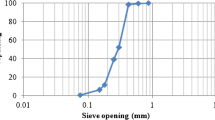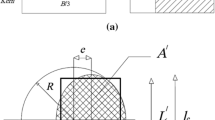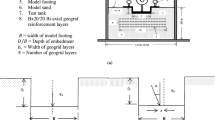Abstract
Numerical model test results for the ultimate bearing capacity (UBC) of a shallow strip footing resting on geogrid reinforced sand subjected to eccentric vertical loading are presented in the study. The numerical modelling is carried out using finite element tool Plaxis 3D in which the footing of size 5 m × 1 m × 0.1 m (L × B × t) is modelled as plate element which rests on soil volume of 5.05 m × 11 m × 8 m (L × B × H). Deep footing mechanism (i.e. width of reinforcement b is equal to the width of the footing B) is adapted in the present study. Several influencing parameters like relative density of sand (Dr, %), embedment ratio (Df/B), eccentricity ratio (e/B) and number of reinforced layers (N) have been considered to observe the UBC of the footing. 216 numbers of numerical model conditions have been developed where Dr (%) varies from 25 to 75% @25%, Df/B varies from 0 to 1 @0.5, e/B varies from 0 to 0.15 @0.05 and N varies from 0 to 5 @1. The Plaxis model is created and analyzed, following HS Small model. The study reveals that irrespective of Df/B and e/B, among all the simulated conditions, the influence of reinforcement is significant for Dr = 25%. It is observed that the failure envelope is shifting from symmetry to one side as the loading is changing from centric vertical to eccentric vertical. The optimum number of reinforced layers (N) for all the cases was found to be in the range of 2–3, after which the effect of reinforcement seems to have marginal effect on the UBC of the footing.
Access provided by Autonomous University of Puebla. Download conference paper PDF
Similar content being viewed by others
Keywords
1 Introduction
Every civil engineering structure mainly consists of two components, i.e. Superstructure and Foundation. For designing purpose, there is a need to check the stability of foundations subjected to different loading conditions. The stability of a foundation and supporting soil effects the stability of a structure. Since the publications of Terzaghi’s theory on the bearing capacity of shallow foundations in [1], several theoretical and experimental studies have been made by various researchers [2,3,4,5,6]. On basis of plastic theory, Meyerhof [2] extended the surface footing analysis to shallow and deep foundations in a cohesive material with internal friction. He represented the bearing capacity factors in terms of mechanical properties of the material and the physical characteristics of the foundation.
Most of the studies reveal that the estimation of UBC is, in general based on foundation under central and vertical loading conditions. Eccentric loading is observed when bending moments and horizontal thrusts are transmitted from the superstructure to the substructure. The eccentric loading condition is due to the moments acting on the foundation with or without axial forces and their location near property line are some of the reasons. This problem can be analyzed by considering eccentric loading at a distance of e from the centerline of the footing. Due to eccentricity, the overall stability of foundation decreases and it causes a reduction in UBC of the soil. Hence, it is utmost necessary to estimate UBC of foundations under eccentric loading conditions. Empirical procedures developed by Meyerhof [3] estimated the UBC of foundations subjected to eccentric vertical loads. Meyerhof [4] extended the UBC theory by studying the influence of foundation shape and depth, eccentricity and inclination of load, ground water conditions and sloping group. Researchers like Prakash and Saran [5] and Purkayastha and Char [6] studied the behaviour of eccentrically loaded footings.
Das et al. [7] analyzed the surface strip foundations when it is resting on geogrid reinforced sand. They studied the effect on bearing capacity ratio (BCR) by varying foundation width and Dr of sand. An experimental setup with plane strain condition is considered by Sadoglu et al. [8] to carry out tests on shallow strip footings resting on geotextile reinforced sand. Patra et al. [9] determined the influence of depth of embedment on UBC in case of strip footing resting on geogrid reinforced sand. Based on experimental and theoretical analysis, the effect of reinforcement on bearing capacity and optimum number of reinforcement layers was given by Sawwaf [10]. Later, it was extended to layered soil by Sawwaf and Nazir [11]. A series of experiments was conducted by Turker et al. [12] by varying eccentricity ratio and embedment ratio of strip footing resting close to geotextile reinforced sand slope.
Numerical analysis was done by Sadoglu [13] and Nasr and Azzam [14] on centrally and eccentrically loaded strip footing on geotextile-reinforced sand. Farzam et al. [15] explained the shear behaviour of elongated rectangular wall-footing connections under eccentric loads. Reliability analysis of EN 1997 design approaches for eccentrically loaded footings was done by Koker and Day [16]. Dal et al. [17] predicted the footings with geogrid reinforcement and biaxial eccentricity using multi-linear regression (MLR) and artificial neural network (ANN) methods.
2 Materials Used
2.1 Soil
Sand with different relative densities (Dr) 25, 50, 75% considered in the present study from Kulhawy and Mayne [18]. By substituting relative density values in empirical formulas which are mentioned in Brinkgreve et al. [19], remaining soil properties in Table 1 are calculated. The soils assumed to behave as elastic-perfectly plastic material and hence considered Hardening soil with small stiffness (HS small) model criterion. The basic feature of HS small model is stress dependency of soil stiffness. A cubical soil volume of 5.05 m × 11 m × 8 m (L × B × H) considered for soil geometry. Table 1 lists out the mechanical properties of soil.
2.2 Footing
An elastic plate with dimensions of 5 m × 1 m × 0.1 m (L × B × t) is simulated to represent footing in the numerical analysis. Linear-Elastic-Isotropic nature adopted for the footing used in present numerical analysis. The mechanical properties of footing are tabulated in Table 2.
2.3 Reinforcement
In Plaxis 3D, reinforcement layers were modelled by using geogrid option, which represents a structural tensile element with unit thickness and tensile strength. Deep slab mechanism is considered for placing reinforcement in the present study. No slip between the soil and reinforcement is assumed and hence no interface elements are used in the present study. The geogrid behaves as an elastic material, which can have only tensile resistance but no compressive and flexural resistance. The tensile strength of geogrid is incorporated in terms of axial stiffness per metre length of the geogrid.
The use of geogrid as reinforcement in geotechnical applications bacame unique advantage programme, especially in the case of foundations resting on weak soils. The soil-reinforcement interface friction is one of the key factors which derive additional shear strength to the original soil.
It is well known that, soil strength increases with increase in the reinforcement, up to a certain extent, which is the reason behind the increased application of reinforcement techniques in the field of geotechnical engineering. The mechanical properties of reinforcement element are tabulated in Table 2.
3 Methodology and Modelling
3.1 Methodology
In the present study, a finite element programme Plaxis 3D is employed to model the footing resting on sand without reinforcement and with reinforcement. In present study, the inclusion of reinforcement is done by considering the deep footing mechanism (i.e. the width of reinforcement b is equal to the width of the footing B) following the procedures explained in Huang and Menq [20].
3.2 Modelling
The numerical modelling is done using step by step construction. In the first step, soil volume is created and material properties are assigned. In the next step, footing is modelled as plate and plate properties are assigned. Then, loading is placed on the footing. It is assumed that groundwater table is not existing below the footing. 15 nodded elements are used to generate the mesh for soil volume. Coarse type of mesh is considered for present numerical analysis to make the calculations easy and less time consuming. The staged construction mode has been adopted to stimulate the procedure of construction practices. In this mode, different phases are considered to define soil, footing, reinforcement and loading. Pre-defined points are taken for stress analysis. In the present study, pre-defined points are considered under loading.
The whole analysis is presented in two cases, unreinforced and reinforced as shown in Figs. 1 and 2. Figure 1 shows that eccentrically loaded strip footing resting on sand without reinforcement for Df/B = 0, Dr = 25% and e/B = 0.15. Figure 2 shows that eccentrically loaded strip footing resting on sand with reinforcement for Df/B = 0, Dr = 75% and e/B = 0.15. The first layer of reinforcement is placed at a depth of u/B = 0.35.
Several influencing parameters like relative density of sand (Dr, %), embedment ratio (Df/B), eccentricity ratio (e/B), and number of reinforced layers (N) have been considered to observe the UBC of the footing. 216 number of numerical models had been developed where Dr (%) varies from 25 to 75% @25%, Df/B varies from 0 to 1 @0.5, e/B varies from 0 to 0.15 @0.05 and N varies from 0 to 5 @1. Numerical soil model created and analyzed, following the HS Small model while for footing Linear-Elastic model is used.
4 Results and Discussions
4.1 Validation of Results
The numerical test results obtained for unreinforced case compared with Meyerhof [4] indicating reasonable accuracy as shown in Fig. 3. It is noticed that the present results are in good agreement with those reported by Meyerhof [4].
4.2 Effect of Relative Density
The variation of UBC with relative density of soil is shown in Fig. 4. From Fig. 4, it is found that there is an increase in UBC with increase in Dr of soil for same value of load eccentricity. For a particular value of relative density of soil, reduction in UBC observed with increase in load eccentricity.
4.3 Effect of Embedment Depth
The variation of UBC with embedment depth of footing as shown in Fig. 5. From Fig. 5, it is clear that UBC increases with increase in depth of embedment of footing for same relative density of soil. For a particular depth of embedment of footing, increase in UBC observed with increase in Dr of soil.
4.4 Effect of Reinforced Layer
Figure 6 shows the variation of UBC ratio (BCR) versus number of reinforcement layers (N) for e/B = 0.1 and Df/B = 0. From Fig. 6, it is noticed that reinforcement effect observed more at N = 3 for all relative densities considered in the present study. After 3rd layer of reinforcement, there is a marginal effect on the ultimate UBC with increase in reinforced layers.
4.5 Effect of Eccentricity Ratio
Figure 7 shows the effect of eccentricity ratio on UBC of soil. From Fig. 7, it is found that there is a decrease in UBC with increase in eccentricity ratio for same relative density of soil. For a particular value of eccentricity ratio, increase in UBC observed with increase in relative density.
4.6 Failure Pattern
Failure pattern for both centric vertical and eccentric vertical loaded strip footing on geogrid reinforced sand as shown in Figs. 8 and 9. From Fig. 8, it is observed that there is symmetry failure pattern for centric load. From Fig. 9, it is observed that failure pattern shifted to one side as in case of eccentric load.
5 Conclusions
In the present study, numerical analyses have been done for two hundred and sixteen model conditions using Plaxis 3D to observe the UBC of shallow strip foundation on geogrid reinforced sand subjected to eccentric vertical loading with varying relative density (Dr%), embedment ratio (Df/B) and number of geogrid layers (N). Based on the results obtained from the study, the following inference are drawn:
-
The optimum number of reinforced layers for centric and eccentric was found to be in range of 2–3, after which the effect of reinforcement seems to have marginal effect on the ultimate bearing capacity of footing.
-
The reinforcing effect is significant in case of loose sand (Dr = 25%).
-
When the loading changed from centric vertical to eccentric vertical, the failure pattern shifted from symmetry to eccentrically loaded side.
References
Terzaghi, K.: Theoretical Soil Mechanics. John Wiley & Sons, New York (1943)
Meyerhof, G.G.: The ultimate bearing capacity of foundations. Geotechnique 2(4), 301–332 (1951)
Meyerhof, G.: The bearing capacity of foundations under eccentric and inclined loads. In: Proceedings of the 3rd International Conference on SMFE, vol 1, pp 440–445 (1953)
Meyerhof, G.G.: Some recent research on the bearing capacity of foundations. Can. Geotech. J. 1(1), 16–26 (1963)
Prakash, S., Saran, S.: Bearing capacity of eccentrically loaded footings. J. Soil Mech. Found. Div (1971)
Purkayastha, R.D., Char, A.N.: Stability analysis for eccentrically loaded footings. J. Geotechn. Geoenviron. Eng. 103 (ASCE 13014 Proceeding) (1977)
Das, B.M., Shin, E.C., Omar, M.T.: The bearing capacity of surface strip foundations on geogrid-reinforced sand and clay—a comparative study. Geotech. Geol. Eng. 12(1), 1–14 (1994)
Sadoglu, E., Cure, E., Moroglu, B., Uzuner, B.A.: Ultimate loads for eccentrically loaded model shallow strip footings on geotextile-reinforced sand. Geotext. Geomembr. 27(3), 176–182 (2009)
Patra, C.R., Das, B.M., Atalar, C.: Bearing capacity of embedded strip foundation on geogrid-reinforced sand. Geotext. Geomembr. 23(5), 454–462 (2005)
El Sawwaf, M.: Experimental and numerical study of eccentrically loaded strip footings resting on reinforced sand. J. Geotechn. Geoenviron. Eng. 135(10), 1509–1518 (2009)
El Sawwaf, M., Nazir, A.: Behavior of eccentrically loaded small-scale ring footings resting on reinforced layered soil. J. Geotechn. Geoenviron. Eng. 138(3), 376–384 (2011)
Turker, E., Sadoglu, E., Cure, E., Uzuner, B.A.: Bearing capacity of eccentrically loaded strip footings close to geotextile-reinforced sand slope. Can. Geotech. J. 51(8), 884–895 (2014)
Sadoglu, E.: Numerical analysis of centrally and eccentrically loaded strip footing on geotextile-reinforced sand. Geosynth. Int. 22(3) (2015)
Nasr, A.M., Azzam, W.R.: Behaviour of eccentrically loaded strip footings resting on sand. Int. J. Phys. Model. Geotechn. 17(3), 177–194 (2016)
Farzam, M., Sadaghian, H., Khodadade, G.: Shear behaviour of elongated rectangular wall–footing connections under eccentric loads. Mag. Concr. Res. 71(1), 43–54 (2018)
de Koker, N., Day, P.W.: Reliability analysis of EN 1997 design approaches for eccentrically loaded footings. Proc. Inst. Civil Eng.-Geotechn. Eng. 172(2), 113–120 (2018)
Dal, K., Cansiz, O.F., Ornek, M., Turedi, Y.: Prediction of footing settlements with geogrid reinforcement and eccentricity. Geosynth. Int. 1–12 (2019)
Kulhawy, F.H., Mayne, P.W.: Manual on estimating soil properties for foundation design (No. EPRI-EL-6800). Electric Power Research Inst., Palo Alto, CA (USA); Cornell Univ., Ithaca, NY (USA). Geotechnical Engineering Group (1990)
Brinkgreve, R.B.J., Engin, E., Engin, H.K.: Validation of empirical formulas to derive model parameters for sands. Num. Methods Geotechn. Eng. 137–142 (2010)
Huang, C.C., Menq, F.Y.: Deep-footing and wide-slab effects in reinforced sandy ground. J. Geotechn. Geoenviron. Eng. 123(1), 30–36 (1997)
Author information
Authors and Affiliations
Corresponding author
Editor information
Editors and Affiliations
Rights and permissions
Copyright information
© 2021 The Author(s), under exclusive license to Springer Nature Singapore Pte Ltd.
About this paper
Cite this paper
Balaiah, K.V., Sasmal, S.K., Alla, V., Behera, R.N. (2021). UBC of Eccentrically Loaded Strip Foundation Resting on Geogrid Reinforced Sand. In: Patel, S., Solanki, C.H., Reddy, K.R., Shukla, S.K. (eds) Proceedings of the Indian Geotechnical Conference 2019. Lecture Notes in Civil Engineering, vol 137. Springer, Singapore. https://doi.org/10.1007/978-981-33-6466-0_21
Download citation
DOI: https://doi.org/10.1007/978-981-33-6466-0_21
Published:
Publisher Name: Springer, Singapore
Print ISBN: 978-981-33-6465-3
Online ISBN: 978-981-33-6466-0
eBook Packages: EngineeringEngineering (R0)













